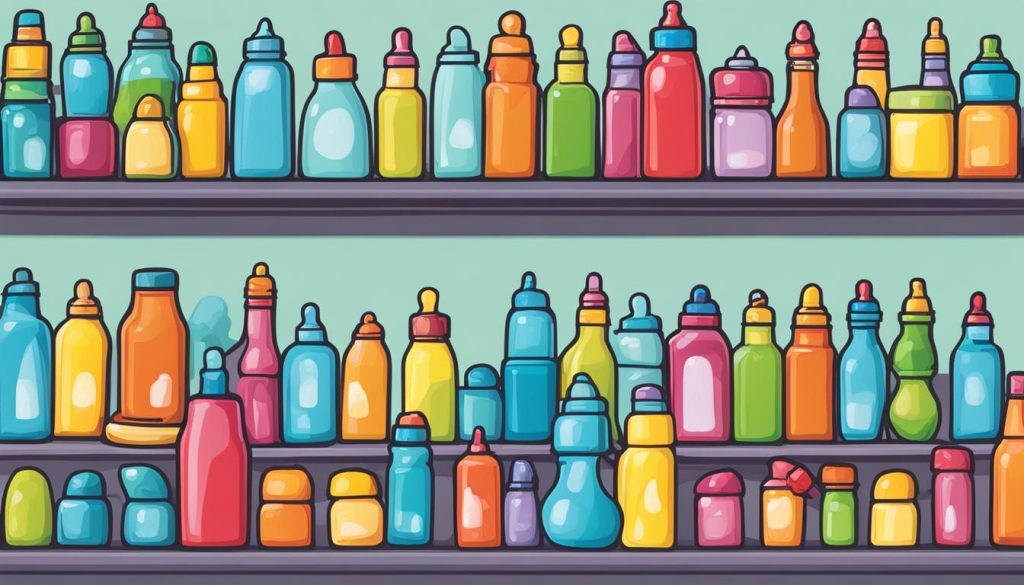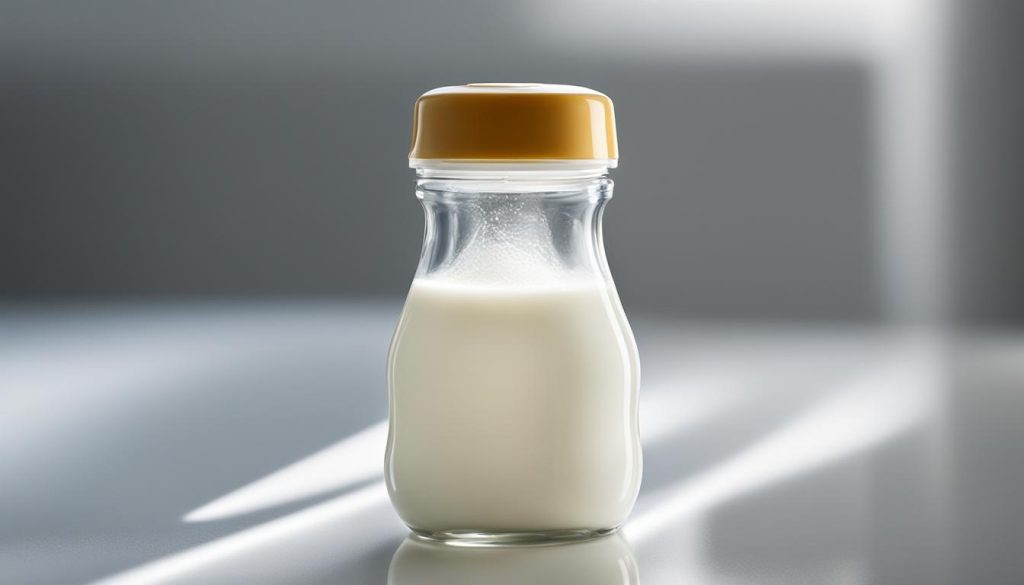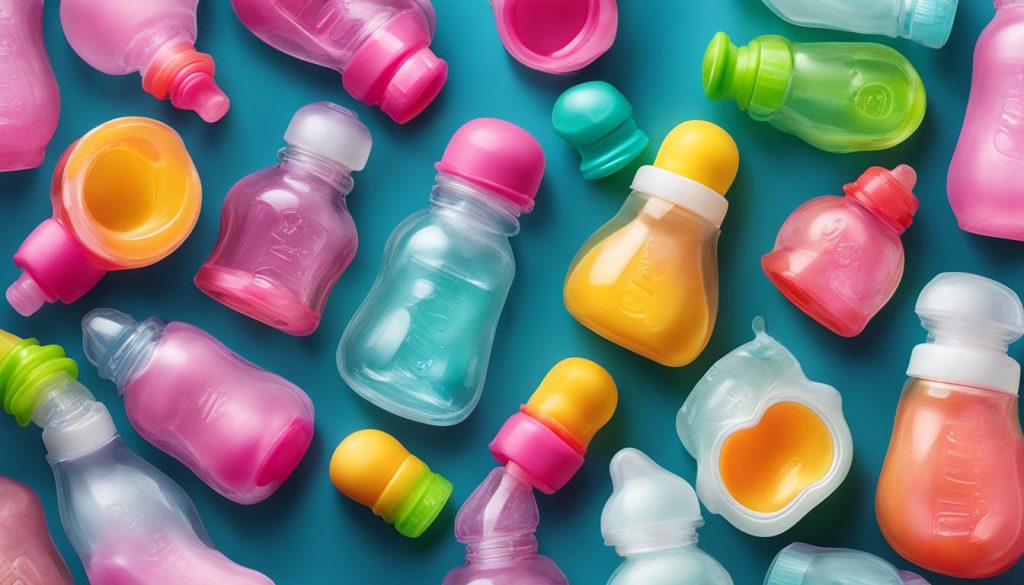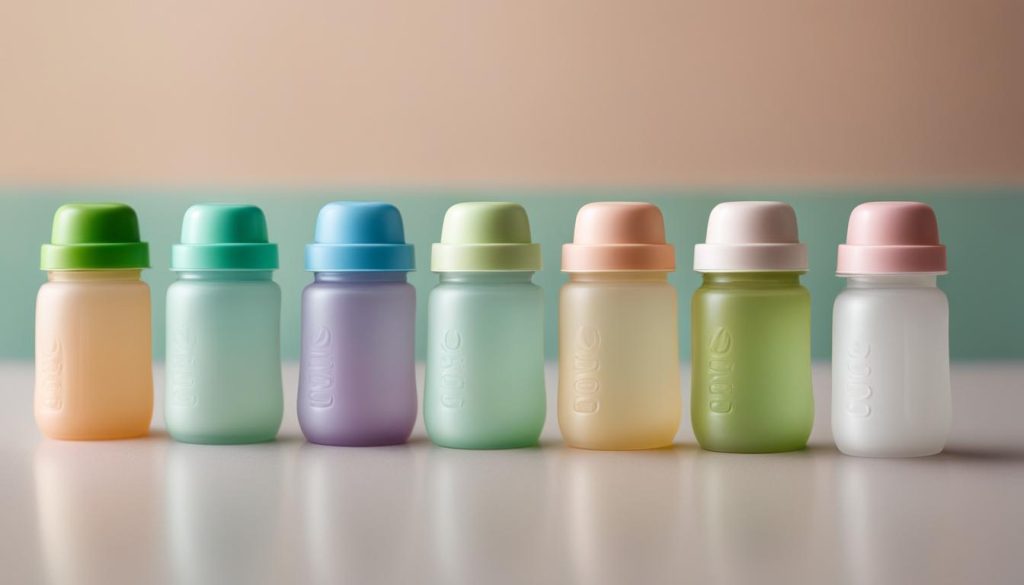When it comes to feeding your newborn, choosing the right baby bottle size is essential. Different bottle sizes for babies are available, but how do you know which one is the right fit? In this guide, I will provide you with valuable insights on how to choose the right size baby bottle for your little one. Let’s dive in!
Firstly, it’s important to understand the standard baby bottle sizes in the market. These sizes typically range from 4 ounces to 9 ounces. The size you choose will depend on factors such as your baby’s age, appetite, and feeding routine. By selecting a bottle size that aligns with your baby’s needs, you can ensure they are getting the right amount of milk during each feeding.
When considering different bottle sizes for babies, keep in mind that newborns will typically start with smaller bottles, such as 4 or 5 ounces, as their stomachs are still small. As your baby grows, you can gradually increase the bottle size to accommodate their increasing appetite.
So, how do you choose the right size baby bottle? Take into account your baby’s age, weight, and feeding habits. If your baby tends to finish a 4-ounce bottle quickly and is still hungry, it may be time to consider moving up to a larger size. On the other hand, if your baby is struggling with a larger bottle and seems overwhelmed, it might be best to stick with a smaller size.
Remember, every baby is unique, and it may take some trial and error to find the perfect fit. Pay attention to your baby’s cues during feedings, observe their comfort level, and consult with pediatricians or lactation consultants for additional guidance.
Choosing the right baby bottle size is an important step in ensuring your baby’s feeding experience is comfortable and satisfying. By understanding the different bottle sizes for babies and considering your baby’s individual needs, you can make an informed decision that supports their healthy growth and development.
Types of Baby Bottles: Materials and Options
When it comes to choosing the right baby bottle for your little one, there are various types of materials and options to consider. Each type has its own advantages and considerations, allowing you to find the perfect fit for your baby’s needs.
Glass Baby Bottles
Glass baby bottles are known for their durability and non-toxic properties. They are a popular choice among parents who prioritize safety and sustainability. Glass bottles are sturdy and can withstand high temperatures, making them easy to sterilize. However, they tend to be heavier than other types of bottles, which may impact portability.
Plastic Baby Bottles
Plastic baby bottles are lightweight and shatterproof, making them a convenient option for on-the-go parents. They are generally more affordable than glass bottles and come in a variety of shapes and sizes. However, it’s important to choose BPA-free plastic bottles to ensure your baby’s safety.
Silicone Baby Bottles
Silicone baby bottles offer flexibility and durability. They are soft and squeezable, mimicking the feel of a breastfeeding experience. Silicone bottles are lightweight and easy to clean, often dishwasher safe. They are a great option for parents who prioritize convenience and ease of use.
Ultimately, the choice between glass, plastic, or silicone baby bottles depends on your preferences and your baby’s needs. Consider factors such as safety, durability, and ease of cleaning when making your decision. Always check the manufacturer’s guidelines and consult with your pediatrician for additional advice.
| Material | Advantages | Considerations |
|---|---|---|
| Glass | Durable, non-toxic, easy to sterilize | Heavier than other types, less portable |
| Plastic | Lightweight, shatterproof, affordable | Choose BPA-free options for safety |
| Silicone | Flexible, durable, mimics breastfeeding | Lightweight, easy to clean |
Importance of Baby Bottle Nipple Sizes
When it comes to feeding your baby, the size of the bottle nipple is an important consideration. Baby bottle nipple sizes determine the flow rate of milk or formula, and finding the right size can help ensure a comfortable and efficient feeding experience for your little one.
Nipple levels, also known as flow levels, are categorized based on age, but it’s essential to remember that every baby is unique. While the recommended nipple size may be suitable for most babies within a certain age range, it’s crucial to observe your baby’s feeding cues and adjust as needed.
Slow flow nipples, often labeled as level 1 or newborn nipples, are designed for newborns who have a smaller feeding capacity and need a slower milk flow. These nipples mimic breastfeeding, ensuring that your baby consumes an appropriate amount of milk without overwhelming them. On the other hand, faster flow nipples, such as level 2 or 3 nipples, are suitable for older babies who consume larger quantities of milk and are more adept at feeding.
Matching Nipple Size with Feeding Needs
Choosing the right nipple size for your baby can be a delicate balance. It’s important to consider your baby’s age, feeding habits, and overall comfort. If you notice signs of frustration during feedings, such as your baby sucking fiercely or becoming agitated, it may indicate that the current nipple size is not appropriate.
Here are some key points to keep in mind when matching nipple size with your baby’s feeding needs:
- Slow flow nipples (level 1 or newborn nipples) are ideal for newborns and young babies who are still developing their strong sucking reflex and require a slower flow.
- Medium flow nipples (level 2 or 3 nipples) are suitable for babies aged 3-6 months who are consuming larger volumes of milk and have a more proficient sucking reflex.
- Fast flow nipples (level 3 or higher) are designed for older babies who are capable of sustaining a faster flow and can handle larger quantities of milk or formula.
Remember, it’s always best to consult with your pediatrician or lactation consultant for personalized guidance on choosing the right nipple size for your baby’s unique needs. They can provide expert advice and ensure that your baby’s feeding experience is safe, comfortable, and enjoyable.
| Nipple Level | Age Range | Flow Rate |
|---|---|---|
| Level 1 (Slow Flow) | Newborns | 1-2 ounces per minute |
| Level 2 (Medium Flow) | 3-6 months | 2-4 ounces per minute |
| Level 3 (Fast Flow) | 6+ months | 4+ ounces per minute |
Remember, finding the right nipple size for your baby may require some trial and error. Paying attention to your baby’s cues, consulting with experts, and being flexible in your approach can help ensure that your baby’s feeding experience is both nourishing and comfortable.
Guide to Baby Bottle Nipple Sizes
Choosing the right baby bottle nipple size is essential for your baby’s comfort and feeding experience. Nipple sizes can vary between brands, but here’s a general guide based on age and development:
| Age | Nipple Size |
|---|---|
| Preemie | Level 0 |
| Newborn | Level 1 |
| 3-6 months | Level 2 |
| 6+ months | Level 3 |
For premature babies, preemie nipples are designed to provide a slow flow suitable for their delicate feeding needs. Newborn nipples, or level 1 nipples, are designed with a slow flow to mimic breastfeeding and accommodate their smaller mouths.
As your baby grows and becomes more efficient at sucking, you can transition to level 2 nipples, which offer a medium flow suitable for babies aged 3-6 months. These nipples allow for a faster flow to accommodate their increased milk intake.
For older babies aged 6 months and above, level 3 nipples are available. These nipples have a faster flow to match their growing feeding needs. It’s important to note that these guidelines are general recommendations, and you should always observe your baby’s feeding cues to ensure they are comfortable and not overwhelmed by the flow rate.
Additional Considerations
While age is an important factor in choosing the right nipple size, it’s not the only consideration. Every baby is unique, and their feeding preferences may differ. Some babies may have a stronger suction, while others may prefer a slower flow. It’s important to monitor your baby’s feeding behavior and adjust the nipple size accordingly.
It’s also worth mentioning that nipple sizes may vary between brands, so it’s essential to check the specific guidelines provided by the manufacturer. Additionally, always ensure that the nipple is properly cleaned and inspected for wear and tear to maintain your baby’s safety and hygiene during feeding.
By considering your baby’s age, development, and individual feeding needs, you can select the appropriate nipple size to promote a comfortable and enjoyable feeding experience for both you and your baby.
Tips for Choosing the Right Baby Bottle and Nipple
When it comes to choosing a baby bottle and nipple, there are several factors to consider in order to find the right fit for your little one. It’s important to pay attention to your baby’s individual needs and preferences to ensure a comfortable and enjoyable feeding experience. Here are some tips to help you make the best choice:
Material and Shape
The material and shape of the baby bottle can impact your baby’s feeding experience. Glass bottles are a popular choice for their durability and ease of sterilization. Plastic bottles are lightweight and shatterproof, making them a convenient option for on-the-go parents. Silicone bottles offer flexibility and are easy to clean. Consider your baby’s needs and your own preferences when deciding on the material and shape that works best for you.
Nipple Size and Flow
Choosing the right nipple size and flow is crucial for your baby’s comfort and feeding ability. It’s important to match the nipple size with your baby’s age and feeding needs. Slow flow nipples are suitable for newborns who are learning to coordinate their sucking and swallowing. As your baby grows and consumes more milk, you may need to switch to faster flow nipples to accommodate their increased feeding speed. Keep an eye out for signs that it’s time to switch nipple sizes, such as your baby becoming fussy or taking longer to finish a feeding.
Signs it’s Time to Switch Nipple Sizes
There are a few signs that indicate it may be time to switch to a different nipple size. If your baby is sucking fiercely, getting frustrated during feedings, or experiencing excessive gas or spit-up, it could be a sign that the current nipple size isn’t providing enough or is providing too much milk flow. It’s important to monitor your baby’s feeding cues and adjust the nipple size accordingly to ensure optimal feeding.
| Nipple Size | Age Range |
|---|---|
| Slow flow | Newborns |
| Medium flow | 3-6 months |
| Fast flow | 6+ months |
Remember, every baby is unique, so it may take some trial and error to find the perfect baby bottle and nipple that suits your little one’s needs. By considering factors such as material, shape, nipple size, and flow, you can ensure a comfortable and enjoyable feeding experience for both you and your baby.
Bottle Maintenance and Sterilization Tips for New Parents
Proper baby bottle maintenance and sterilization are essential for keeping your baby healthy and safe. By following a few simple steps, you can ensure that your baby’s bottles are clean and free from harmful bacteria.
Regular Cleaning Routine
It’s important to establish a regular cleaning routine for your baby’s bottles. After each feeding, dismantle the bottle and separate the parts, including the nipple, collar, and bottle. Rinse all parts with warm water to remove any leftover milk or formula. Use a bottle brush with mild dish soap to scrub the bottles and nipples thoroughly. Pay close attention to any crevices or hard-to-reach areas where milk residue might accumulate. Rinse all parts again with warm water to remove any soap residue. Allow the bottles and parts to air dry on a clean, dry towel or rack.
Sterilization Methods
Sterilizing your baby’s bottles is an important step to eliminate any remaining bacteria. There are several methods you can use to sterilize the bottles:
- Boiling: Place the cleaned bottles and parts in a pot of boiling water and let them boil for at least five minutes. Make sure the bottles are fully submerged in the water and avoid overcrowding the pot.
- Steam Sterilizer: Use an electric steam sterilizer, following the manufacturer’s instructions. This method is quick and efficient, killing bacteria through high-temperature steam.
- Microwave Sterilizer: If you choose to use a microwave sterilizer, make sure it is specifically designed for baby bottles. Follow the instructions provided, as heating times may vary depending on the wattage of your microwave.
Replacing Bottles and Nipples
Regularly inspect your baby’s bottles and nipples for signs of wear and tear. Over time, nipples can become worn out or damaged, which may affect their performance. If you notice any cracks, tears, or changes in the nipple’s shape, it’s time to replace it. Similarly, if the bottles show signs of wear, such as scratches or discoloration, it’s a good idea to invest in new ones. Keeping your baby’s bottles in good condition ensures a safe and hygienic feeding experience.
| Sterilization Method | Advantages | Disadvantages |
|---|---|---|
| Boiling | Simple and cost-effective | Requires careful monitoring of boiling time |
| Steam Sterilizer | Quick and efficient | Requires the use of electricity |
| Microwave Sterilizer | Convenient and time-saving | May cause uneven heating if not used correctly |
Remember, maintaining clean and sterilized baby bottles is crucial for your little one’s health. By following these maintenance and sterilization tips, you can ensure a safe and enjoyable feeding experience for your baby.
Expert Advice on Baby Bottle Sizes and Feeding
When it comes to choosing the right baby bottle size and ensuring a successful feeding journey, expert advice can be invaluable. Lactation consultants, pediatricians, and experienced parents have shared their insights and tips to help guide you in this important decision. Here are some expert recommendations to consider:
1. Observe Your Baby’s Feeding Cues
Experts suggest paying close attention to your baby’s feeding cues as a starting point for determining the right bottle size. Every baby is unique, and their appetite and preferences can vary. Look for signs of hunger, such as rooting, sucking on fists, or increased alertness, as indicators that your baby may need a larger bottle size. On the other hand, if your baby seems easily overwhelmed or is showing signs of discomfort during feeding, a smaller bottle size may be more suitable.
2. Seek Guidance from a Lactation Consultant
A lactation consultant can provide personalized guidance and support when it comes to choosing the right baby bottle size and feeding techniques. They can assess your baby’s latch, feeding rhythm, and overall development to help determine the most appropriate bottle size. A lactation consultant can also offer tips on bottle-feeding positions, pacing, and troubleshooting common issues like reflux or colic. Their expertise can greatly enhance your feeding experience and help you feel more confident in meeting your baby’s needs.
3. Consider Your Baby’s Developmental Stage
Expert advice recommends considering your baby’s age and developmental stage when selecting a bottle size. As babies grow, their appetite and swallowing abilities evolve. It’s important to choose a bottle size that keeps up with their increasing intake while ensuring comfortable and efficient feeding. Depending on your baby’s age, you may need to transition to a larger bottle size that accommodates their growing needs. The guidance of experts can help you navigate these transitions smoothly.
Incorporating the expert advice mentioned above into your decision-making process can help you choose the right baby bottle size and enhance your baby’s feeding experience. Remember, there is no one-size-fits-all approach, and it’s essential to be attentive to your baby’s needs and preferences. Consulting with professionals and experienced parents can provide valuable insights and support along the way.
| Expert Tips for Baby Feeding |
|---|
| 1. Observe your baby’s feeding cues to determine the right bottle size. |
| 2. Consult with a lactation consultant for personalized guidance and support. |
| 3. Consider your baby’s age and developmental stage when selecting a bottle size. |
Conclusion: Finding the Perfect Baby Bottle Size
After exploring the world of baby bottle sizes, it’s clear that finding the right fit for your baby is crucial for their feeding experience. By understanding the different types of bottles available, such as glass, plastic, and silicone, you can choose the one that best suits your baby’s needs and preferences.
Equally important is considering the size of the bottle nipple. Slow flow nipples are ideal for newborns, while faster flow nipples are suitable for older babies who consume more milk. Remember to refer to the baby bottle nipple size chart to ensure the perfect match based on your baby’s age and feeding requirements.
When choosing a baby bottle and nipple, it’s essential to observe your baby’s feeding cues and be mindful of signs that indicate it’s time to switch nipple sizes. Additionally, maintaining and sterilizing the bottles regularly is paramount for your baby’s health and safety.
In conclusion, finding the perfect baby bottle size is a combination of understanding your baby’s individual needs, selecting the right bottle and nipple, and seeking expert advice when needed. By considering all these factors, you can provide your baby with a comfortable and enjoyable feeding experience. Remember, choosing the right bottle is a journey, and I encourage you to explore different options until you find the perfect fit for your little one.
FAQ
What are the different types of baby bottles available?
There are various types of baby bottles including glass, plastic, and silicone bottles. Glass bottles are sturdy but heavier, while plastic bottles are lightweight and shatterproof. Silicone bottles offer flexibility and durability.
How do I choose the right nipple size for my baby?
Nipple sizes are categorized based on age, but every baby is different. Slow flow nipples are suitable for newborns, while faster flow nipples are appropriate for older babies who consume more milk. It’s important to match the nipple size with your baby’s feeding needs.
What are the different baby bottle nipple sizes?
Baby bottle nipple sizes can vary between brands, but here’s a general guide: Level 0 nipples are for preemies, level 1 nipples are for newborns, level 2 nipples are for babies aged 3-6 months, level 3 nipples are for babies aged 6 months and older, and level 4 nipples are for babies aged 9 months and older.
How do I know when to switch nipple sizes?
Look for signs that indicate it’s time to switch nipple sizes, such as your baby sucking fiercely or seeming frustrated during feedings. Observing your baby’s feeding cues is essential in determining the right time to switch nipple sizes.
How do I clean and sterilize baby bottles?
Wash new bottles and nipples before use, clean them thoroughly after each feeding, and regularly check for signs of wear. Sterilize the bottles using hot, soapy water or a dishwasher. It’s important to follow proper bottle maintenance and sterilization practices for your baby’s health and well-being.
What should I consider when choosing a baby bottle and nipple?
Consider factors such as your baby’s individual needs, material, shape, and size of the bottle, as well as the flow rate of the nipple. It’s important to choose a bottle and nipple that suits your baby’s preferences and feeding habits.
Can I consult with experts for guidance on baby bottle sizes and feeding?
Yes, consulting with a lactation consultant can provide valuable insights and guidance on feeding techniques, nipple types, and more. They can offer personalized advice based on your baby’s needs and help you find the best bottle size for your little one.
How do I find the perfect baby bottle size for my baby?
Finding the perfect baby bottle size requires attention to your baby’s needs and cues. By considering factors such as nipple sizes, bottle materials, and feeding preferences, you can ensure that your baby has a comfortable and enjoyable feeding experience.




